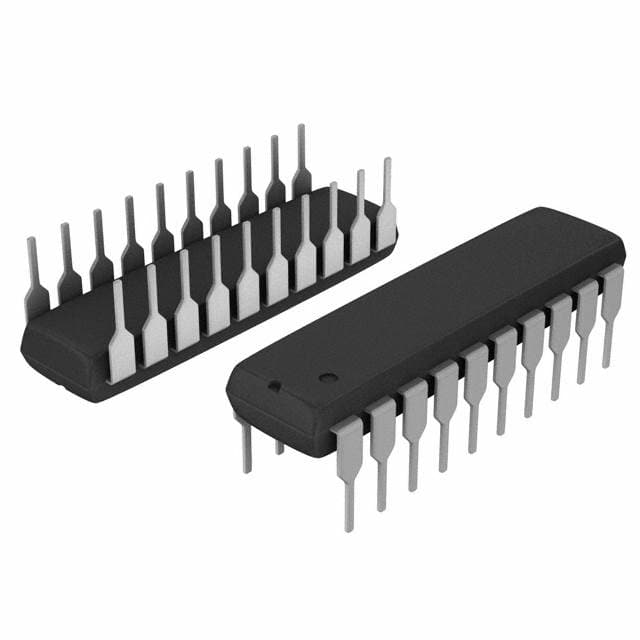Viz Specifikace pro podrobnosti o produktu.

Encyclopedia Entry: 74F541PC
Product Overview
Category
The 74F541PC belongs to the category of integrated circuits (ICs) and specifically falls under the family of octal buffers/drivers with 3-state outputs.
Use
This product is commonly used as a buffer or driver in digital electronic systems. It provides a means to control the flow of data between different parts of a circuit, ensuring proper signal transmission.
Characteristics
- Octal buffer/driver with 3-state outputs
- High-speed operation
- Wide voltage range compatibility
- Low power consumption
- Robust design for reliable performance
Package
The 74F541PC is typically available in a dual in-line package (DIP), which consists of a rectangular plastic body with two parallel rows of pins extending from the bottom.
Essence
The essence of the 74F541PC lies in its ability to amplify and transmit digital signals while providing a high impedance state when not actively driving the output.
Packaging/Quantity
This product is usually packaged in tubes or trays, with each containing multiple units. The exact quantity may vary depending on the manufacturer's specifications.
Specifications
- Supply Voltage: 4.5V to 5.5V
- Input Voltage: 0V to VCC
- Output Voltage: 0V to VCC
- Operating Temperature Range: -40°C to +85°C
- Maximum Propagation Delay: 10ns
- Maximum Output Current: ±24mA
Detailed Pin Configuration
The 74F541PC has a total of 20 pins, numbered as follows:
- Output Enable (OE)
- Input/Output (IO1)
- Input/Output (IO2)
- Input/Output (IO3)
- Input/Output (IO4)
- Input/Output (IO5)
- Input/Output (IO6)
- Input/Output (IO7)
- Ground (GND)
- Input/Output (IO8)
- Output (Q1)
- Output (Q2)
- Output (Q3)
- Output (Q4)
- Output (Q5)
- Output (Q6)
- Output (Q7)
- Output (Q8)
- VCC
- Output Enable (OE)
Functional Features
- Octal buffer/driver with 3-state outputs allows bidirectional data flow.
- High-speed operation enables efficient data transmission in time-critical applications.
- Wide voltage range compatibility ensures compatibility with various digital systems.
- Low power consumption minimizes energy usage and heat dissipation.
- Robust design provides reliable performance even in challenging environments.
Advantages and Disadvantages
Advantages
- Enables efficient signal buffering and driving in digital circuits.
- High-speed operation facilitates rapid data transmission.
- Wide voltage range compatibility enhances versatility.
- Low power consumption reduces energy costs.
- Robust design ensures reliability in demanding conditions.
Disadvantages
- May require additional components for proper integration into a larger system.
- Limited output current may restrict use in certain high-power applications.
Working Principles
The 74F541PC operates by receiving input signals on its input pins (IO1 to IO8) and amplifying them to drive the corresponding output pins (Q1 to Q8). The Output Enable (OE) pin controls the state of the outputs, allowing them to be actively driven or set to a high impedance state.
Detailed Application Field Plans
The 74F541PC finds application in various digital electronic systems, including but not limited to: - Microprocessors and microcontrollers - Memory systems - Data communication devices - Industrial automation equipment - Automotive electronics
Detailed and Complete Alternative Models
- 74LS541: Low-power Schottky version of the 74F541PC.
- 74HC541: High-speed CMOS version with similar functionality.
- SN54F541: Texas Instruments' equivalent to the 74F541PC.
These alternative models offer similar features and can be used as substitutes depending on specific requirements.
In conclusion, the 74F541PC is a versatile octal buffer/driver IC that provides efficient signal amplification and transmission in digital electronic systems. Its high-speed operation, wide voltage range compatibility, and low power consumption make it suitable for various applications. While it has certain limitations, such as limited output current, alternative models are available to address specific needs.
Seznam 10 běžných otázek a odpovědí souvisejících s aplikací 74F541PC v technických řešeních
Sure! Here are 10 common questions and answers related to the application of 74F541PC in technical solutions:
Q: What is the 74F541PC? A: The 74F541PC is a type of octal buffer/line driver integrated circuit (IC) that can be used for signal buffering and driving applications.
Q: What is the maximum voltage rating for the 74F541PC? A: The maximum voltage rating for the 74F541PC is typically around 5.5 volts.
Q: How many input/output pins does the 74F541PC have? A: The 74F541PC has a total of 20 pins, with 8 input pins and 8 output pins.
Q: Can the 74F541PC handle bidirectional data transfer? A: Yes, the 74F541PC is capable of bidirectional data transfer, making it suitable for applications where data needs to be both input and output.
Q: What is the maximum current that the 74F541PC can source or sink? A: The 74F541PC can typically source or sink up to 15 mA of current per output pin.
Q: Is the 74F541PC compatible with TTL logic levels? A: Yes, the 74F541PC is designed to be compatible with TTL (Transistor-Transistor Logic) logic levels.
Q: Can the 74F541PC operate at high speeds? A: Yes, the 74F541PC is a fast IC and can operate at high-speed frequencies, typically in the range of tens of megahertz.
Q: Does the 74F541PC require external pull-up or pull-down resistors? A: No, the 74F541PC has built-in pull-up and pull-down resistors, eliminating the need for external ones in most cases.
Q: Can the 74F541PC be cascaded to drive more than 8 outputs? A: Yes, multiple 74F541PC ICs can be cascaded together to drive a larger number of outputs if needed.
Q: What are some common applications of the 74F541PC? A: The 74F541PC is commonly used in digital systems, such as microcontrollers, memory interfacing, bus drivers, and general-purpose signal buffering applications.
Please note that the answers provided here are general and may vary depending on specific datasheet specifications and application requirements.

